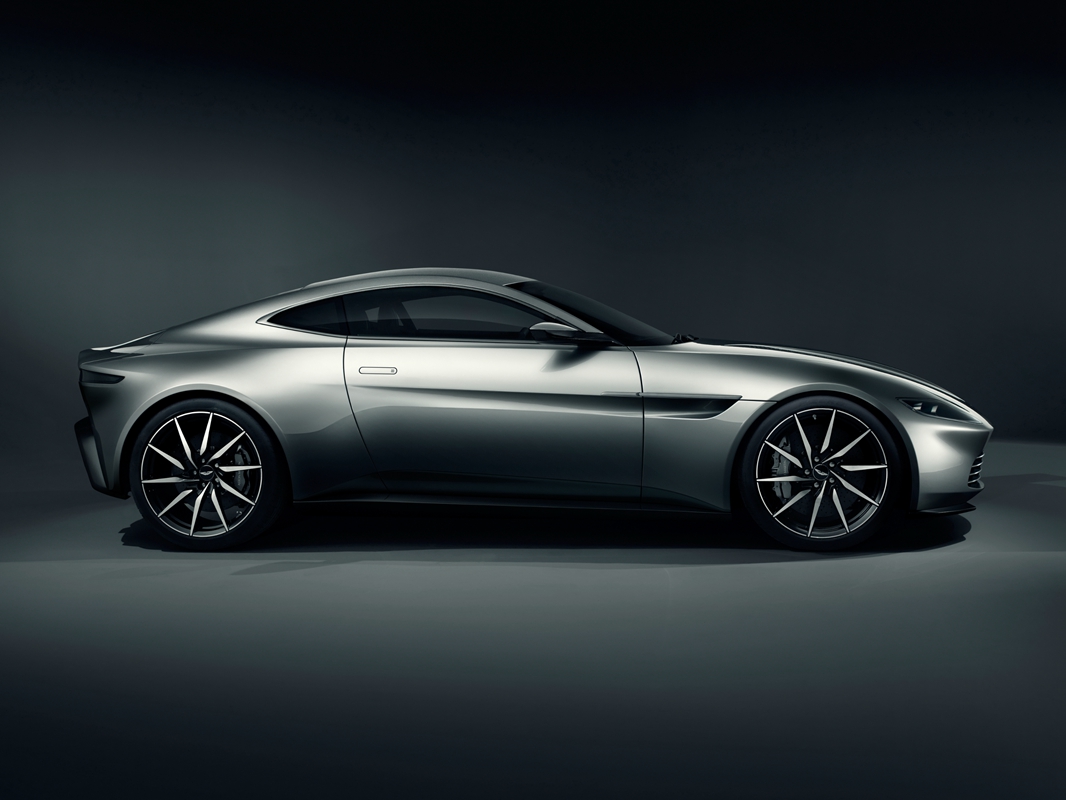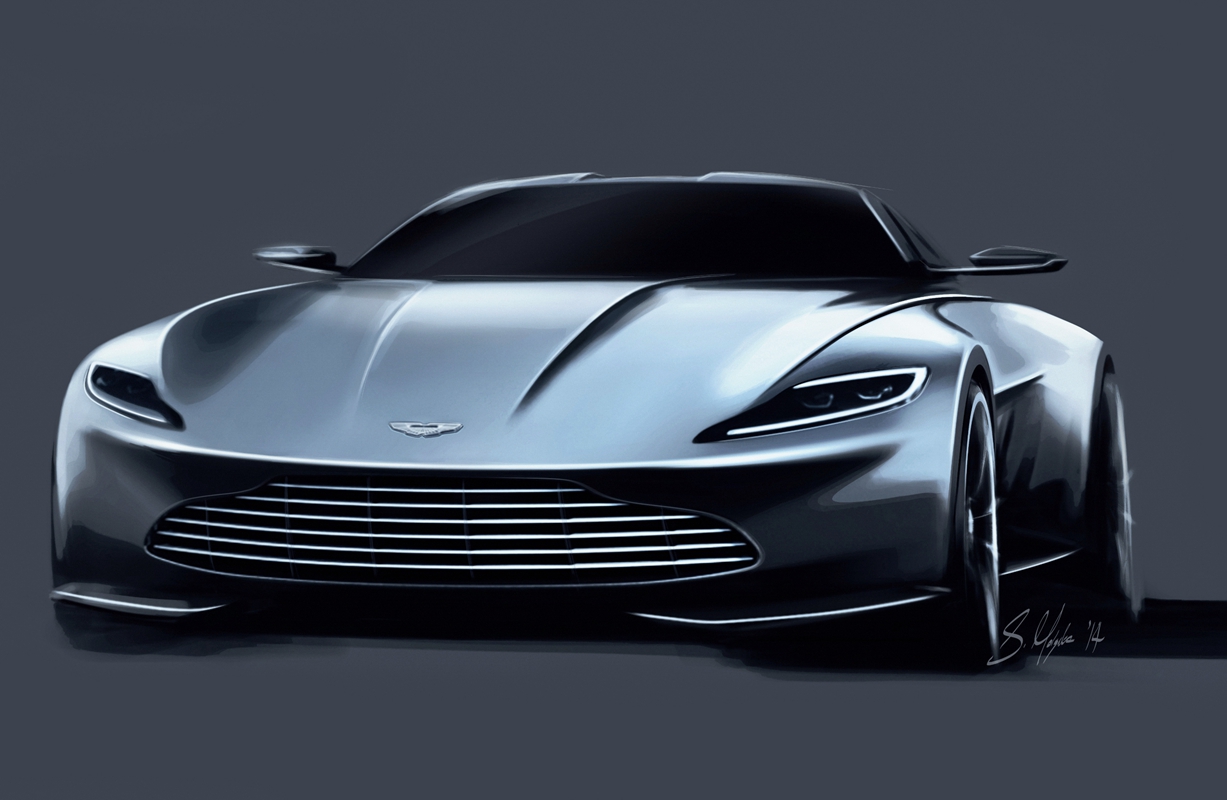 《幽灵党》导演看到了他认为极其适合007的车型草图。
《幽灵党》导演看到了他认为极其适合007的车型草图。 阿斯顿·马丁的首席创意官Reichman希望DB10可以成为年轻一代所钟爱的标志性车型。
阿斯顿·马丁的首席创意官Reichman希望DB10可以成为年轻一代所钟爱的标志性车型。 DB10鲨鱼般的前脸有一种猎手的气势,这与007的风格不谋而合。
DB10鲨鱼般的前脸有一种猎手的气势,这与007的风格不谋而合。
在007新片《幽灵党》中,丹尼尔·克雷格终于不用和阿斯顿·马丁DB10大秀合影,但车内设施的展示,和一场超长的追逐戏,让DB10在电影中出尽了风头。为了赶上电影的拍摄,从草图设计到生产出一辆功能齐备的车,阿斯顿·马丁的工程团队仅仅花了6个月的时间。
从1964年的《金手指》开始,阿斯顿·马丁就与邦德开始了不解之缘,当时DB5还抢了肖恩·康纳利不少戏份。当意昂集团需要为第24部007电影配备一辆车时,他们便出发前往位于英国沃里克郡盖登的阿斯顿·马丁总部。
“意昂集团的团队来到我们这里,导演Sam Mendes和制片人Barbara Broccoli问我们手头有什么车,”阿斯顿·马丁首席创意官Marek Reichman说道。“我们展示了几辆还没上路的概念车。Mendes看到了一辆未来车型的草图,他很喜欢,觉得这就是詹姆斯·邦德可能会驾驶的车。”
意昂集团要求我们提供10辆DB10,因为一部分车辆可能会在拍摄过程中损毁,特别在与另一辆概念车捷豹C-X75进行追逐的一个长镜头中,风险比较高。而要生产出这10辆功能齐全的车,能够使用的时间却非常有限。
“我们4月份画出了草图,9月份就交出了原型车,” Reichman表示。“要在6个月里生产出一批能够开的车绝非易事。而且它们还必须非常牢固,因为这些车辆都要在特技表演中使用。”
设计团队使用了许多阿斯顿·马丁业已成熟的技术,其中包括全部用碳纤维制作的车身和铝合金底盘。但是许多生产技术与真正的量产车的生产方式还是有很大差异的。
“我们使用了快速原型和激光扫描等技术,从CAD图纸到成品一步到位。许多部件都是从原材料中直接切割并加工而成,因此我们无需等待模具的完成。” Reichman表示。
为007电影设计汽车需要打破许多常规。DB10主要是由特技驾驶员驾驶的,他们的表演需求与传统的安全和舒适功能要求有很多不同,像牵引控制和防抱死制动这样的功能,他们并不需要。
“在研发过程中,我们进行了许多创新;我们要求这辆车能完成普通汽车做不到的事情,” Reichman表示。“有些时候,车辆会需要失去牵引力,因此我们给驾驶员设计了一个液压手刹来帮助实现这一状态。此外我们还在轮胎的橡胶上做了许多改进,以实现正确的气压水平。”
Reichman不愿透露意昂集团提出了哪些具体的个性化要求,但他提到,DB10需要能够从尾气管中喷出50 m(160英尺)长的火焰。“因此,我们在汽车后方下了很大的功夫。”
除了外观之外,车辆的内饰也是专门为这位大名鼎鼎的间谍量身定做的。
“我们必须和他们一起设计道具,还要根据詹姆斯·邦德的使用方式来设计车辆的内部设施。此外我们还要保证,这些道具能够呈现出真实的效果。” Reichman表示。
汽车参与拍摄的过程同样困难重重。Reichman指出,安装在横梁和其他位置的摄像机很重,对车身和架构造成的压力甚至高出了特技驾驶。
“有两辆车是参与媒体活动的,因此没有受损,”他表示。“另外一些车辆的内饰并不齐全,因为车辆中需要安装很多用来固定摄像机的支架和设施。有几辆车确实受损了,但受损原因并不是进行了特技表演,而是吊在上面的摄像机。”
尽管许多影迷更容易记住道具和特技,但Reichman更加钟情于DB10的外形设计。他说《金手指》中的DB5成为了上几代人所钟情的典型车型,而他希望DB10也能成为年轻一代最喜爱的车型。
“在我看来,这辆车就詹姆斯·邦德会开的车,它不仅具有动力和美感,而且还是一名真正的猎手,” Reichman表示。“如果要做比喻的话,它的前脸长的非常像鲨鱼。”
作者:Terry Costlow
来源:SAE《汽车工程杂志》
翻译:SAE上海办公室
Concept car to production in six months fits 007’s timeline
Daniel Craig won’t have to share marquee billing with the Aston Martin DB10, but the usual gadgets and an extended chase scene give the car a major role inSpectre, the latest James Bond movie. Aston Martin’s engineering team were integral in the movie’s timeline, going from rough sketches to fully functioning vehicles in only six months.
Aston Martin and Bond have been linked since the DB5 stole some scenes from Sean Connery in Goldfinger in 1964. When the team from Eon needed a car for their 24th Bond movie, they headed to Aston Martin’s headquarters in Gaydon, Warwickshire, UK.
“The team from Eon came over, Sam Mendes (director) and Barbara Broccoli (producer) asked what we had,” said Marek Reichman, Chief Creative Officer at Aston Martin. “We showed them the cars in our pipeline that weren’t on the road. Mendes saw a sketch of a future model and said he loved it, that it fit his thinking of the kind of car James Bond would drive.”
Eon asked Aston Martin for 10 DB10s, figuring that some of them wouldn’t survive filming, especially a lengthy chase scene with another concept vehicle, a Jaguar C-X75. The timeframe for producing the fully-functioning performance vehicles was tight.
“We took the sketches in April and turned out prototypes by September,” Reichman said. “It was a challenge to generate a series of working cars in six months. They had to be very durable, the cars are driven hard in stunts.”
The design team used technologies that Aston Martin has experience with, including a fully carbon fiber body attached to an aluminum chassis. But many of the manufacturing techniques were vastly different from those of true production vehicles.
“We used things like rapid prototyping and laser scanning, and we went directly from CAD to finished parts. Many components were machined, cut from solids so we did not have to wait for the creation of molds,” Reichman said.
Designing for a 007 movie required several other deviations from the norm. The DB10 was driven primarily by stunt drivers who are far more interested in tricks and performance than conventional safety functions or creature comforts. Features like traction controls and antilock braking were not high on their list.
“There was a lot of novelty in the development; we asked this car to do things cars don’t normally do,” Reichman said. “It had to lose traction, the driver was able to lose traction using a hydraulic hand brake. We also put a lot of development into the rubber in the tires and finding the right air pressure.”
Reichman wouldn’t talk about any of the customizations added by Eon and Q, though he noted that the DB10 shoots a 50-m (160-ft) flame from its exhaust. “We had to do a lot on the back of the car so it could shoot a jet of flame,” he said.
The interior was also altered to suit the needs of the world’s best-known spy.
“We had to work with them on the gadgets. We had to develop the interior to fit how James Bond would use it. We had to work with them to make it look real despite the added gadgets,” Reichman said.
Filming was tough on vehicles. Reichman noted that the weight of cameras mounted on booms and other spots on the cameras caused more stress on the body and frame than the rigors of stunt driving.
“Two hero cars will be part of the release publicity; they were undamaged,” he said. “A lot of the cars don’t have full interiors; they have cages and attachments to hold cameras. The ones that have been destroyed were not destroyed by the action but by the cameras hanging off them.”
While many movie fans will mainly remember the gadgets and stunts, Reichman is more enamored with the styling of the DB10. He noted that the DB5 in Goldfingerbecame a true icon for previous generations. He hopes that the DB10 will achieve iconic status for Generations X and Y, among others.
“In my thinking, it’s befitting what James Bond would drive, it’s got everything: it has power, it has beauty, and it’s a predator,” Reichman said. “If I liken this to anything, the front looks very much like a shark.”
Author: Terry Costlow
Source: SAE Automotive Engineering Magazine
等级
打分
- 2分
- 4分
- 6分
- 8分
- 10分
平均分
